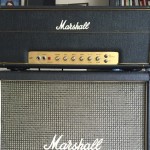When people most often think of vintage Marshalls, the most highly regarded are the non-master volume series including the model 1959 100 watt head produced in the late 1960’s and early 1970’s. It’s hard to argue against the amp that Hendrix, Page, Van Halen, Clapton and many others used.
And while I would agree that they are incredible amps, the REAL game changer in my mind for Marshall was when the company introduced its master volume series of amps in 1976. The models 2203 (100 watts) and 2204 (50 watts) heads became instant hits, and quickly began to outsell the non-master volume versions by the late 70’s. Why? Well, they sounded great at more reasonable volumes which essentially made them more practical for guitarists who couldn’t always play at full volume and crank up a non-master volume Marshall inside a concert arena.
Continue reading
